
A bright future
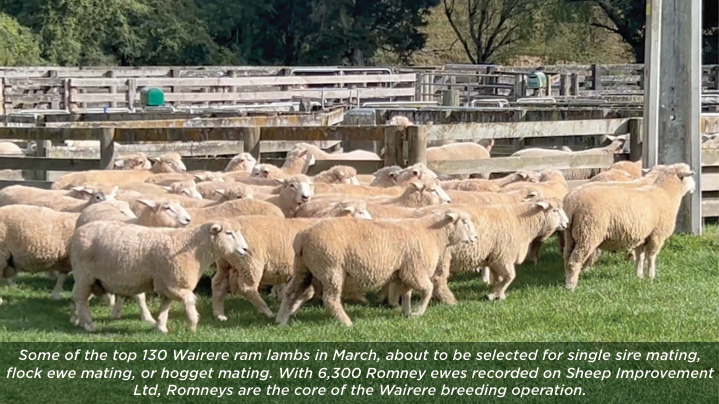
The 2025 financial year is ending much better than it started. But the first half of the year still ranked in the misery index for those of us/you who had to sell most lambs and ewes before Christmas. Or were hammered by storms. Or endured the summer/autumn drought which impacted severely on parts of the North Island. At Wairere we seem to have been in a rain shadow since April 2023, the two years since averaging 655mm per year against a long term average of 1125mm. We have had to drop stocking rate to squeeze through.
Supply/demand
However, big parts of the world have been hit harder. This is showing up particularly with global beef supply from North and South America. Add in the recent flooding which drowned 1.3 million cattle in Australia.
An elevated price for beef lifts the price of sheep meat. The epicentre of Australian prime lamb production, Victoria and South Australia, is still waiting for the “autumn break”. The drought has been so bad that 50-100% of pastures will need to be resown when the break does arrive. Shortage of stock water has forced lots of farmers in that region to sell capital stock. It is inevitable that Australian lamb production will be down in 2025-26.
So will New Zealand lamb production. Sheep numbers continue to retreat as more trees are planted, less fertiliser is applied, and cattle are substituted for sheep. But, let’s recognise that high performance sheep have carried breeding farm profitability for 80% of the last twenty five years. And will again.
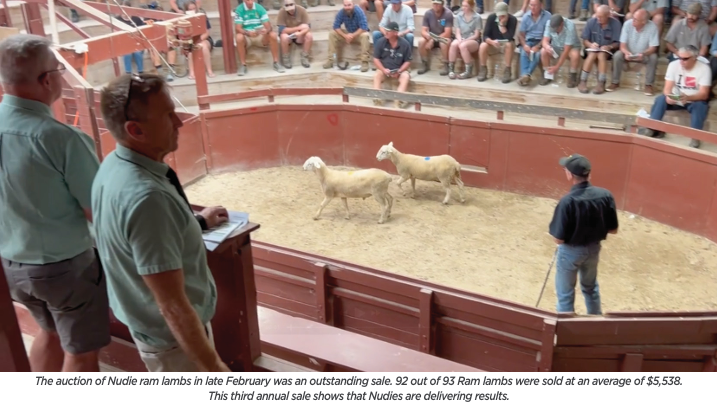
Predictions
It is not easy to predict how Tariffgate will affect world trade. But the global supply/demand equation for red meat spells out a promising several years ahead. And the Global Dairy Trade auction price continues to increase.
The lower exchange rate with the Euro, the Pound, and the US dollar is already helping sheep farmer returns.
Given the dire state of the New Zealand economy, with the government borrowing more than a million dollars per hour, the trend has to be further weakening of the exchange rate, which will benefit all exporters.
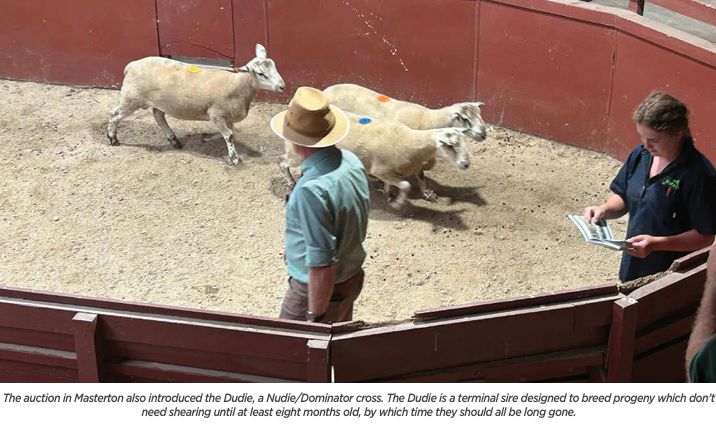
What is Wairere doing about your key issues?
Parasite resistance to drenches is the big animal health challenge which needs a solution. There is no silver bullet. Genetics can help but
management is key.
An example: In 2023 William Wallace and son Mark were awarded Best Supplier of the Year to Atkins Ranch, with 99.59% in spec and on time across 9,000 lambs supplied that year.
William and his son Mark have a finishing block in central Hawkes Bay. They finish cattle on half the block and lambs on the other half, then swap over the following season. Could we do that on hill country breeding farms?
William also tried a Nudie ram lamb over some ewes on hill country, and was very impressed with the growth rate of the progeny. So bought a second ram lamb at the Nudie auction this year.
Cropping
A “balanced” breeding/finishing sheep farm has around twenty percent of cultivable finishing
country to eighty percent hill. Wairere has less than two percent flat land, so represents those of you with very little cultivation or direct drilling possible. We have sprayed and prayed several times. The last time we did it coincided with the 2008 drought, and a dry season in 2009, so grew more thistles than rape or summer turnips. Spray and Pray (aerial cropping) has worked well for us when rain comes at the right time, but is more vulnerable to crop failure than cultivation or direct drilling. And sometimes climatic conditions don’t favour lamb thrift on any feed crops, lots of money spent and a disappointing result.
But it is one way to deal with the exponential rise in parasitic larvae in March/April/May.
Fast growth rate is a solution
The faster lambs can be grown from birth the better. At Wairere we have always regarded growth rate as the most important breeding
value when selecting sires. We haven’t drenched before weaning for decades. When lambs enjoy a high protein diet from mother’s milk and spring clover, that helps offset any worm burden. Ideally, a high proportion of sale lambs are big enough to go POM, no drench required, so no resistance builds up.

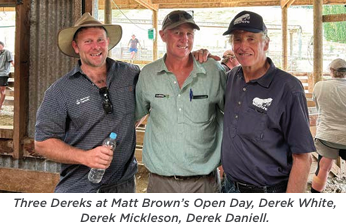
How can we ensure a high protein diet post weaning? Chemical topping with Glyphosphate offers a simple and cheap($40/ha to fly/spray?) way to offer lambs a high clover diet. At Wairere we have chemical topped up to 20% of the farm. That also avoids the risk of buying cattle mid spring when they are at their most expensive.
The CarLA test
Wairere did a third year of Carla testing in late March. The ewe lambs showed a strong immune response at six months old. So did the Nudies, tested in early April.
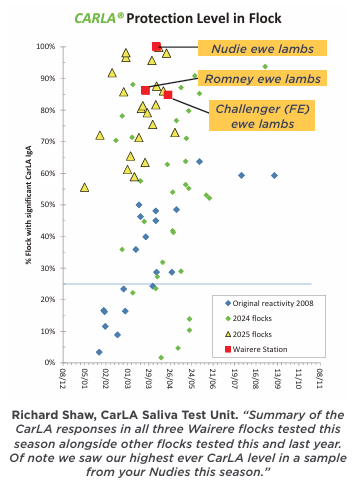
There seems to be some evidence to support anecdotes that Nudies and Wiltshires have better internal parasite resistance than the average New Zealand sheep.
Wairere’s program to breed more resilience/resistance to internal parasites features :
- No drenching of mixed age ewes since 2005
- No drenching of all two tooth ewes since 2005, apart from three years.
- All ewe hoggets have been mated since 1966. Over the past twenty years we have retained around 42,000 pregnant ewe hoggets and 1,500 dry hoggets. Rearing lambs, especially twins, puts a lot of pressure on hoggets, which adds to a worm burden.
- Wairere has run a 15-20% cattle ratio for many years, in contrast to a district average of 30%.
- Wairere has summered a high stocking rate of lambs and wintered a high number of hoggets per hectare, a perfect breeding ground for Trichostrongylus worms. This has helped us select the rams and ewes which best handle this challenge.
Changes at Wairere
- Increasing cattle ratio to get closer to our district norm of 70:30.
- More lambs are being culled at weaning so fewer lambs are carried through the summer.
- We are lambing and weaning ewe hoggets earlier. Weaning most of the hoggets before Christmas gives them more time to recover
before mating as two tooths. - We are growing a lower number of ewe lambs better, targeting an average mating weight of 46kg.
Rob Dick, Wairarapa. Rob farms on flat land south of Masterton. For many years he has taken 1,600 White Rock Wairere Romney ewe lambs at 28-29kgLW around December 20th, grazed them for twelve months, and returned them to White Rock as 68-69kg two tooths a
year later.
Rob: “It has taken me a few years to realise that these hoggets perform best at an average weight of 46kg mated. I sow 40ha of rape around Labour Weekend. The lambs come off the truck onto the crop, so parasite larvae contamination of pasture is avoided. The 1600 hoggets docked 94% in 2024. I get paid for weight gain of 40kg and a small bonus for every kilo above 60kg…plus lamb income. White Rock gets excellent life time performance from a 68-69kg two tooth ewe. It’s a win/win.”
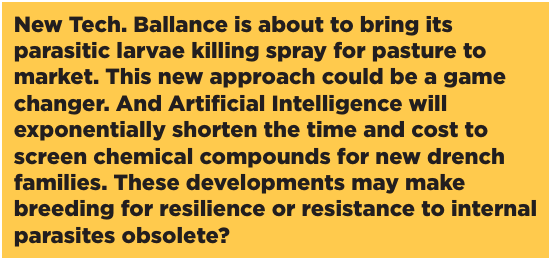
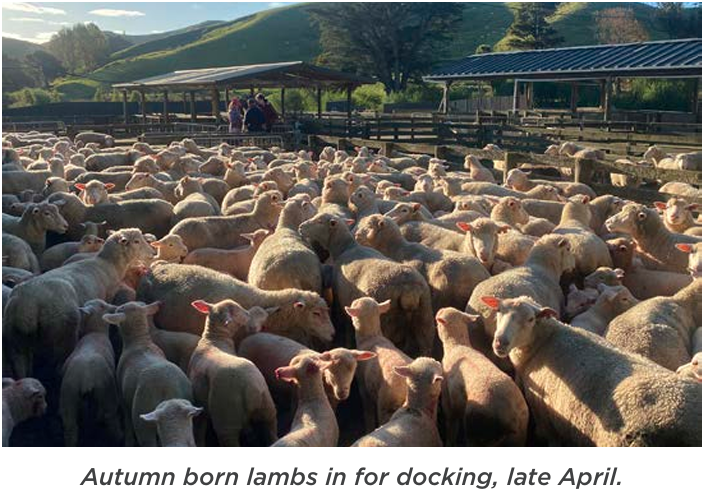
Wairere expanding
In early May Wairere bought 577ha of hill country in conjunction with several shareholders who are already involved with the Wairere ram business. This move will reduce our cost structure from sheep grazing on other farms.
Pierre Syben will farm 370ha of this new block. He has managed farms for around five years during his main career as a stock agent.
Autumn Lambing?
In February, Wairere purchased some of Craig Hickson’s flock. For twenty years Craig has been rigorously selecting ewes which lamb three times every two years, March, November and July, with a third of the flock lambing at each of those dates. From disappointing results in the early years, Craig has bred a flock which now performs consistently well. From 162 ewes set stocked on steep hills we docked 226 lambs in May this year.
Craig has now leased all his farm land, so had to find a home for these ewes. This concept of lambing three times per year has real merit in the right environment allowing an average 2.1 lambs per ewe per year. We bought these ewes and sires to save the flock, but Wairere doesn’t
have the climate for this concept. If anyone is interested in buying this flock, ring the farm office at 063725784, or Simon on 0274988587.
Wool you, won’t you?
In March Beef and Lamb and the Whakapapa Catchment Group organised a field day at John Petersen’s farm near Taumarunui. There were three speakers representing wool. They were representatives of WoolWorks, Wool Impact, New Zealand Merino. All three painted an optimistic outlook for wool, with programs in place to encourage more demand. Ross Richards, a King Country ram breeder, and I both spoke.

Ross has a Wiltshire flock, but said that his Coopworths were much more productive. I said that Wairere has a foot in either camp. “It would be ideal for NZ’s sheep industry if wool regained lost value and grossed $500-1,000 per hectare on hill country. In today’s dollar value, wool was earning around $1500 per hectare in the 1970s.
The best potential driver of enhanced value of wool is the deconstruction process into pigments and powder. The Wool Source development program is a slow burn. Most R and D programs take three times as long and cost three times as much as originally envisaged (though Ukraine has developed new weapons in very short order!). Wool Source has excellent support from WRONZ and MPI”.
Is politicking worthwhile?
On May 6th I was on the steps of Parliament for the handover of a petition calling for New Zealand’s animal welfare standards to apply to imports. Pork and liquid egg imports are the key targets of this campaign. Around 60% of pig meat consumed in NZ comes from countries which still allow sow stalls.
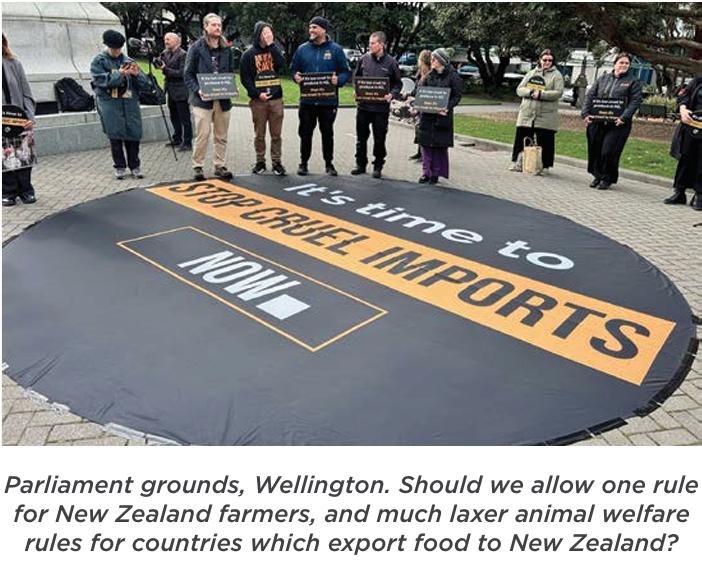
It was a great opportunity to talk to a few MPs one on one. This is a private member’s bill which has attracted cross party support. Two MPs told me that they would far rather have collaboration for common sense solutions than adversarial politics. There are more MPs from a farming background in the current Parliament than there have been
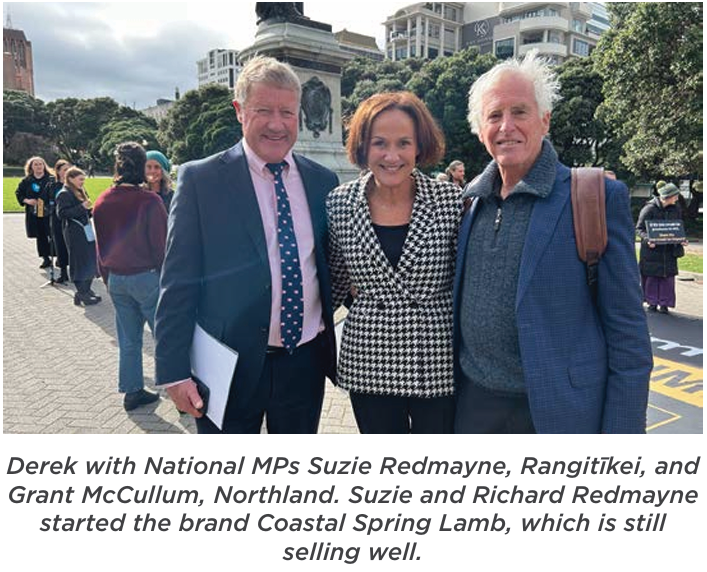
for more than fifty years. As farmers we should make use of this rebalance in our favour.
Despite suffering from submission fatigue myself, I recognise that the squeaky wheel gets the grease. Agriculture has been undermined by lobby groups, and 99% of farmers don’t have the time or want to engage…and then the lobby groups get their way. Add to that the kowtowing that New Zealand has to do to some trading partners because of the Paris Accord. We have lost ten percent of our grassland in the last ten years, mostly because of this scam of blaming animals for manmade climate change. A large meat processing company is paying “zero carbon beef” suppliers a premium at the farm gate…but can’t get a premium from the market! When are we going to stop pretending?
What can you control?
You control the inputs, management, timing, and genetics for your farming operation.
Beyond the farm gate, Wairere has put time, money and effort into politicking on behalf of the sheep sector, and accelerating the adoption of new technology.
Inside the farm gate, Wairere continues to optimise genetic progress and create breeding options for clients.

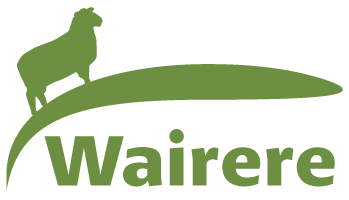

Recent Comments